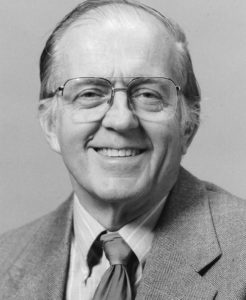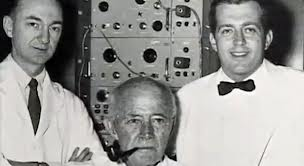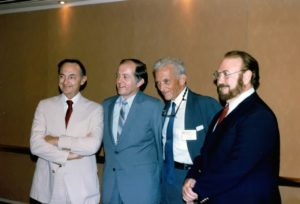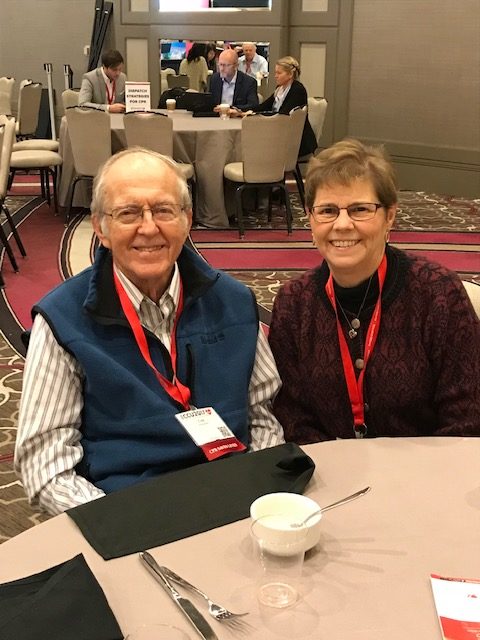As a graduate student at Johns Hopkins University, Guy Knickerbocker, PhD, was one of three researchers who developed cardiopulmonary resuscitation, also known as CPR, which has saved countless lives.

Guy Knickerbocker, PhD
He died June 21, 2022 in Narvon, PA. He was 89.
Knickerbocker was an electrical engineer and doctoral student at Johns Hopkins University where he collaborated with William Kouwenhoven, PhD, also an electrical engineer and professor, and James Jude, MD, a cardiac surgeon and resident at The Johns Hopkins Hospital, to develop the prototype of the first portable external defibrillator in 1957.
A year later, Knickerbocker made a crucial observation while working with Kouwenhoven and Jude. He discovered that pressure on the chest during defibrillation experiments in animals produced an arterial wave form and a temporary rise in blood pressure. This observation paved the way toward a new technique, which is now known as CPR.
The team published their research breakthrough on the value of external cardiac massage in providing blood flow to vital organs for people in cardiac arrest in the Journal of the American Medical Association in 1960.
“Anyone, anywhere, can now initiate cardiac resuscitative procedures,” the researchers noted in the landmark paper. “All that is needed are two hands.”

From left to right: Drs. James Jude, William Kouwenhoven and Guy Knickerbocker are regarded as the “Fathers of CPR.”
The brilliant trio would come to be regarded as “the fathers of CPR.”
In the early 1960s, Knickerbocker also collaborated with others to produce the training film titled, “Pulse of Life,” which was viewed by millions and popularized CPR.
Throughout his career, he published over 30 articles about electricity and the human body, according to his obituary.
William Montgomery, MD, FAHA, who serves as the coordinator for the International Liaison Committee on Resuscitation (ILCOR), said Knickerbocker will always be remembered for his incredibly important work in the laboratory and in training activities.
Montgomery first met Knickerbocker at an AHA National Conference on CPR and Emergency Cardiovascular Care (ECC) in 1985 when Knickerbocker was among the first group of “Giants” in resuscitation science honored by the AHA for their landmark contributions to CPR and emergency cardiovascular care.

Left to right: Drs. James Jude, Guy Knickerbocker, Peter Safar and James Elam were among the first group of “Giants” in resuscitation science honored by AHA in 1985 at the organization’s National Conference on CPR and Emergency Cardiovascular Care (ECC).
Montgomery said in recent years, Knickerbocker and his wife, Joan, attended the Citizen CPR Foundation’s Emergency Cardiac Care Conference (ECCU), where he met with cardiac arrest survivors who were saved because of his breakthrough research.
“Those survivors were so happy to meet with him in person and individually and take pictures ‘with the man who invented the technique that saved their lives,’ Montgomery recalled. “These were very warm and emotional meetings and Guy was always very gracious with everyone.”
It was during the ECCU events where Dianne Atkins, MD, chair of the AHA ECC Committee, would meet with Knickerbocker.
“He was always a very pleasant man and willing to have his picture taken with everyone who asked,” Atkins remembered. “He seemed quite humble about his accomplishments with respect to CPR, but also was quietly proud of them.”
Atkins said it is now known that immediate CPR, usually delivered by a lay rescuer, is a primary determinant of survival with good functional outcome. Yet, she said less than 50% of patients in cardiac arrest in the U.S. receive CPR before EMS arrives.

Dianne Atkins meets with Guy Knickerbocker at the ECCU event in 2017.
“The AHA and the ECC need to commit to better understanding how to engage the lay public in understanding the need for CPR, improve the percentage of those who receive lay rescuer CPR and to ensure that our teaching methods are the most effective for providing high-quality CPR,” she said.
Knickerbocker and his research team fundamentally changed the way in which patients with cardiac arrest are treated, said Comilla Sasson, MD, vice president of ECC Science and Innovation at AHA. To continue his legacy, she said that the AHA is committed to teaching CPR to everyone.
“The American Heart Association is dedicated to making sure every person knows how to perform CPR, and can help save a life,” Sasson said. “And that all people, regardless of where they live or what healthcare system they are treated in, will have an equitable chance for surviving a cardiac arrest event.”
Another major way that Knickerbocker’s legacy can endure is for AHA and ILCOR to continue to support innovative research, said Robert Neumar, MD, who co-chairs ILCOR.
“We need to advocate for greater investment in resuscitation science and expand the pipeline of young scientists entering the field,” Neumar said.
Montgomery said Knickerbocker will always be remembered as being one of the original scientists and investigators that discovered modern CPR as we know it today.
“Even though he has passed, he will aways live in the hearts and minds of all providers of CPR and survivors as a ‘Giant’ in resuscitation and the person responsible for discovering the technique that ‘saved my life,’ Montgomery said.